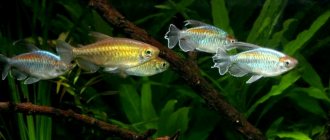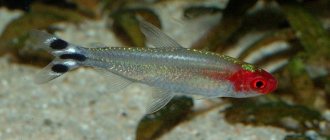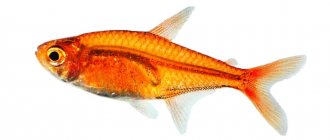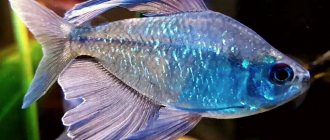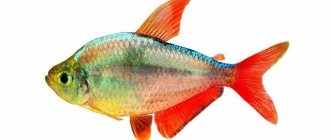The glass tetra belongs to the Characin family. These fish came to us from South America, where they are found in tributaries of the Amazon River basin, rivers of Southern Brazil, Paraguay, and Uruguay.
Aquarium fish are completely unpretentious in maintenance and reproduction. How should she be fed in the fish house, who should she choose as a neighbor, and how should she be bred? Let's find out together.
The body of the glass Tetra is elongated and slender. It is slightly flattened on the sides. The body length reaches 6-7 centimeters. The peculiarity of this fish is its transparency. The skin of this fish is so transparent that the spine and all internal organs are visible through it. The main body color is pale blue or bluish-gray. The fish's head is small, and its eyes are impressive in size. The mouth is upper, small. The lateral and ventral fins of the glass Tetra are transparent, the dorsal fins are yellowish or transparent. The anal fin of the fish is also transparent, it stretches all the way to the tail of the fish. The first rays of this fin are long and blue in color. The caudal fin is bright red. It has two blades. As for sexual differences, females are slightly larger than males. The latter have a brighter body color.
Habitat
It is widespread throughout the Amazon basin in the modern states of Ecuador, Colombia, Peru, Bolivia and Brazil. It lives near the surface in the upper layers of water, mainly in small streams, rivers and channels of larger rivers; it is not found in the main channels.
Brief information:
- Aquarium volume - from 70 liters.
- Temperature - 23–27°C
- pH value – 6.0–8.0
- Water hardness - from soft to hard (2–30 dGH)
- Substrate type - any
- Lighting - dim
- Brackish water - no
- Water movement is weak
- The size of the fish is up to 6 cm.
- Food - any food
- Temperament - peaceful
- Keep a flock of at least 6–10 individuals
Behavior
Peaceful, friendly and very active fish. Keeping in a flock is recommended. At least 4-8 individuals. Ideal companions will be similar in size, non-aggressive representatives of the underwater world, for example: gourami, botia, zebrafish, neons, rasboras, swordtails. Chain catfish and corydoras, shrimp will not only become good neighbors, but will also be able to collect settled food from the bottom. Glass tetras cannot be kept in the same aquarium with large, aggressive and fast fish. Cichlids, goldfish, koi carp, and astronotus are not suitable friends for the glass tetra.
Maintenance and care, arrangement of the aquarium
A group of fish of 6–8 individuals will require a tank of 70 liters. A large number of plants are used in the design, but they are placed in such a way as to preserve significant areas of free space. Floating plants are also welcome and will provide cover if the Glass Tetra senses danger. The lower bottom layers do not have any mandatory requirements and are designed at the discretion of the aquarist; for example, you can place a sandy substrate and install decorative elements (driftwood, sunken ships, castles, etc.). The hydrochemical composition of water is within wide acceptable pH and dGH values. To imitate the water conditions characteristic of the natural habitat, it is recommended to add several fallen leaves and/or cones of deciduous plants and oak bark to the bottom. Over time, the water will turn light brown as the tannins dissolve. The leaves are first dried, then soaked in a container until they begin to sink and only then placed in the aquarium. Leaves are renewed every couple of weeks, cones once a month. A similar effect can be achieved with less effort by using a cloth bag filled with peat and using a filter with peat-based filter material. It is worth noting that peat for the bag is purchased exclusively at a pet store, where it is delivered after special treatment.
Possible diseases
The glass tetra is an unpretentious fish with good health, adaptive abilities, and no tendency to diseases of hereditary or genetic origin. But in some cases, mainly due to improper feeding and unfavorable living conditions, the well-being of these characin representatives may worsen.
Aquarists need to pay special attention to the appearance of warning signs:
- changes in behavior, apathy, lethargy, decreased motor activity;
- color change;
- the appearance of specific spots;
- lack of appetite.
If such signs appear, you should check your water parameters and seek advice from a specialist. It may be necessary to simply change the diet and provide the tetra with more careful care, or perhaps we are talking about serious pathologies that need to be treated competently and in a timely manner.
Some of the most common diseases that glass tetras can be susceptible to include:
- Dropsy - manifested by swelling and an increase in the size of the abdomen. Therapy is carried out using antibiotic drugs.
- Bug -eyed eyes are easily detected by the glass tetra's visual organs protruding from their sockets. Occurs when water quality is poor. In most cases, no special treatment is required. To solve the problem, it will be enough to disinfect the reservoir and replace the water every 2-3 days.
- Plistophorosis is an incurable rare pathology accompanied by appetite disorder, apathy and changes in the color of the body.
- Fin rot - the main symptom is the formation of a specific coating on the fins. It is treated by treating the affected areas with penicillin. To prevent and disinfect water in the aquarium for 2 weeks, it is recommended to add a solution of potassium permanganate and sea salt.
- Hexamitosis is a parasitic disease that is manifested by darkening of the tetra’s color and the appearance of ulcerative lesions on its body. Treatment involves antibacterial therapy and the use of antiseptic solutions.
Since the glass tetra naturally has very good immunity, if timely measures are taken, the disease can be easily treated, without the risk of associated complications and relapses.
Feeding a glass tetra
The natural diet of the glass tetra consists of various small invertebrates, which the fish catch at the surface of the water. At home, it is best to opt for high-quality dry food that can provide your pets with all the nutrients, while vitamins and various functional additives will promote good health and longevity.
Glass tetras are best suited for food that floats on the surface of the water; this is where the fish are most accustomed to feeding. We recommend paying attention to the following:
- TetraPRO Energy Multi-Crisps are innovative chips with a special energy concentrate. The food will not only ensure healthy growth and comfortable digestion, but will also give your glass tetras additional vitality;
- TetraPRO Algae Multi-Crisps or Tetra Phyll Flakes – food with a high content of plant components to strengthen the immune system of fish;
- TetraMin Flakes is a universal food for aquarium fish, made from more than 40 selected ingredients. Promotes good growth and bright color. The flakes are easily crushed and remain on the surface of the water for a long time.
But you can pamper your nimble pets with delicious treats in Tetra FreshDelica nutritious jelly. Bloodworms or daphnia are sure to please your tetras.
Parameters for a spawning aquarium:
- — t – 26-30°C;
- — pH – 6.8-7.2;
- - hardness - 4-6°.
the lighting of the spawning area be dim. The female lays about 400 eggs. After spawning, the parents must be removed. The ripening period of caviar lasts approximately one knock. On the third or fourth day, the fry already begin to swim, at the same time feeding with starter food such as ciliates should be organized (sometimes you can use egg yolk). As the young animals grow older, the amount of feed should be gradually increased!
What to feed
In aquarium conditions, the glass tetra feeds only from the external water surface, so specialized floating food would be an ideal option. The fish is not picky about food and happily eats both live food and pre-frozen food, as well as dry food.
Experts recommend using high-quality products from trusted manufacturers when feeding glass tetras, since both the health and color of the fish largely depend on the quality and composition of the food.
In order to diversify the diet, from time to time the fish can be fed with moths, fruit flies, bread and oatmeal.
It is recommended to feed the glass tetra 2 times a day, giving food in small portions. It is important that the food is absorbed within a few minutes. Otherwise, its remains will settle to the bottom and you will have to clean the aquarium.
Breeding
In an aquarium, breeding glass tetras does not present much difficulty. With properly selected producers and the creation of certain conditions, these fish spawn well.
-Select breeders, preferably one year old (females and males have minor external differences, males are thinner and slimmer, females are larger and plumper); -seat the female and female for 7-10 days, feed with live food, do not overfeed; - prepare a separate aquarium - a spawning tank with a net at the bottom to protect the eggs, also place small-leaved plants on the bottom, where spawning will take place, water temperature for spawning from +26 to +30 C, hardness up to 6%, pH = 6.8 − 7.2; - the lighting is not very bright, diffused.
After 10 days of separate keeping, the breeders are transplanted in the evening into a spawning tank prepared in advance. Spawning begins in the morning: the female lays up to 400 eggs. Spawned fish are removed from the spawning tank. The young emerge from the eggs within a day. On days 3-4, the fry begin to swim and need food. The first food is ciliates and egg yolk. As the fry grow, the need for food increases. It is important to remember that these representatives of the fish world are nimble and jumping; in order to avoid jumping out and death, it is necessary to cover the container with glass.
If all conditions are met, glass tetras live in aquariums for quite a long time, up to 5-6 years.
The glass tetra (Prionobrama filigera) lives in the Madeira River (Brazil). The fish belongs to the Characin family. Reaches up to 7 cm in length. The main background of the body is bluish-gray. The caudal fin is bright red. Anal fin with long base. The fish's internal organs are visible. Males are smaller and slimmer than females. Glass tetra is a peaceful, gregarious species. It lives at the upper and middle water levels.
Appearance
Glass tetra
This unusual fish has a completely transparent body. This can be understood from the name - glass. If you wish, you can even examine the skeleton and insides of this fish. The body is elongated, slightly flattened at the sides. Although the fish is transparent, it has a silvery, silvery-blue hue, with gold in the head area. A narrow light green stripe can be observed along the body. The caudal fin consists of two lobes and is colored reddish-brown (light to deep). An adipose fin is located behind the dorsal fin. The lateral fins are transparent. The head is not large, but the eyes are very large and expressive.
Aquarium fish: how to make the right choice
People who decide to have aquarium fish are faced with a rather difficult question - what kind of pet to choose. If you search well, you will find that you will have to choose from almost 2,000 species of a wide variety of freshwater fish. On this page we tried to collect all the necessary information about the aquarium fish - glass tetra. If you have never had an aquarium before, you don’t need to choose based on the principle of a beautiful fish and an ugly fish. It is necessary to take into account a lot of variables: what kind of food it prefers, the temperature and composition of the water, whether it is a predator or not, whether it is dangerous for humans, whether it gets along with other species, and many other interesting things. If we classify conditionally, we can distinguish two large groups of fish:
- Easy-to-care fish, not at all demanding of environmental conditions, can survive even in unfavorable situations. They have high endurance by nature, because they live in places where water constantly changes its characteristics or even disappears for a while. However, for health and beautiful appearance, such fish need to be provided with conditions as similar as possible to their natural habitat.
- Difficult to care for fish, most of them belong to tropical latitudes. For them, you need to create special conditions in the aquarium, again as similar as possible to the area where they live in nature. These species rarely breed in captivity, so they are brought from the wild.
For a novice fish breeder, it is better to choose one of the most unpretentious species. In addition to the prospect of not being able to cope with caring for a “capricious” fish, there is a danger of introducing an exotic disease that can harm the rest of the flora and fauna of the aquarium. If you like the glass tetra aquarium fish, carefully read the characteristics, character, feeding, care and breeding of these fish.
Sexual Dimorphism
As with many small characins, mature females have a noticeably fuller abdomen, especially in the pre-spawning state. Males develop a dark stripe on the anal fin (next to the white marking present in both sexes) and are said to develop slightly elongated dorsal and anal fins.
Glassy tetra (Prionobrama filigera) female, appearance, difference
Glassy tetra (Prionobrama filigera) male, appearance, difference
Sexual maturity occurs at a standard length of 42 mm in males and 45 mm in females.
Notes
The genus Prionobrama (Vytreous tetras) currently contains only one other species, P. paraguayensis. It is very similar in appearance to P. filigera, but the caudal fin lacks red pigmentation.
Glassy tetra (P. paraguayensis) related species
Red-finned aphiocharax (A. anisitsi) similar species
P. filigera can be easily distinguished from the "other" bloodfin tetra, Aphyocharax anisitsi, by its more elongated body shape and lack of red pigmentation in the anal and ventral fins. For some reason they remain a relatively unpopular species in the aquarium hobby, probably due to their lack of bright colors.
Features of reproduction
And there are no difficulties when breeding tetras. They reach sexual maturity at 6-11 months, depending on the species. The fish do not have a special time for spawning; they simply require preliminary intensive feeding for one week. The more active pair are deposited separately in a spawning tank with a capacity of 20-30 liters, with cleaner water and aeration.
The signal for the start of spawning will be a decrease in acidity and an increase in habitat temperature. At one time, the female brings several hundred eggs, after which she must sit down so that she does not eat the eggs. After a few hours, unfertilized eggs become whitish-cloudy and are removed. The tank is placed in a dark place (the eggs do not like sunlight), after 4-6 days the fry can be seen.
In the first days they will feed on the contents of their pouch. At first, hard-boiled egg yolks and ciliates are useful to them. In the first week, the fry need to be fed more frequently (every three hours), and then less frequently.
Until adulthood, the fry are kept separately. You need to feed finely ground food, live dust or plankton. They love the absence of aeration and perfectly clean water, oxygen saturation and frequent filtration. It is necessary to regularly remove the remaining food and dead larvae. In just two weeks, the fry become accustomed to living conditions similar to those of adults.
Coloring begins to appear towards the end of the first month. They have good survivability.

